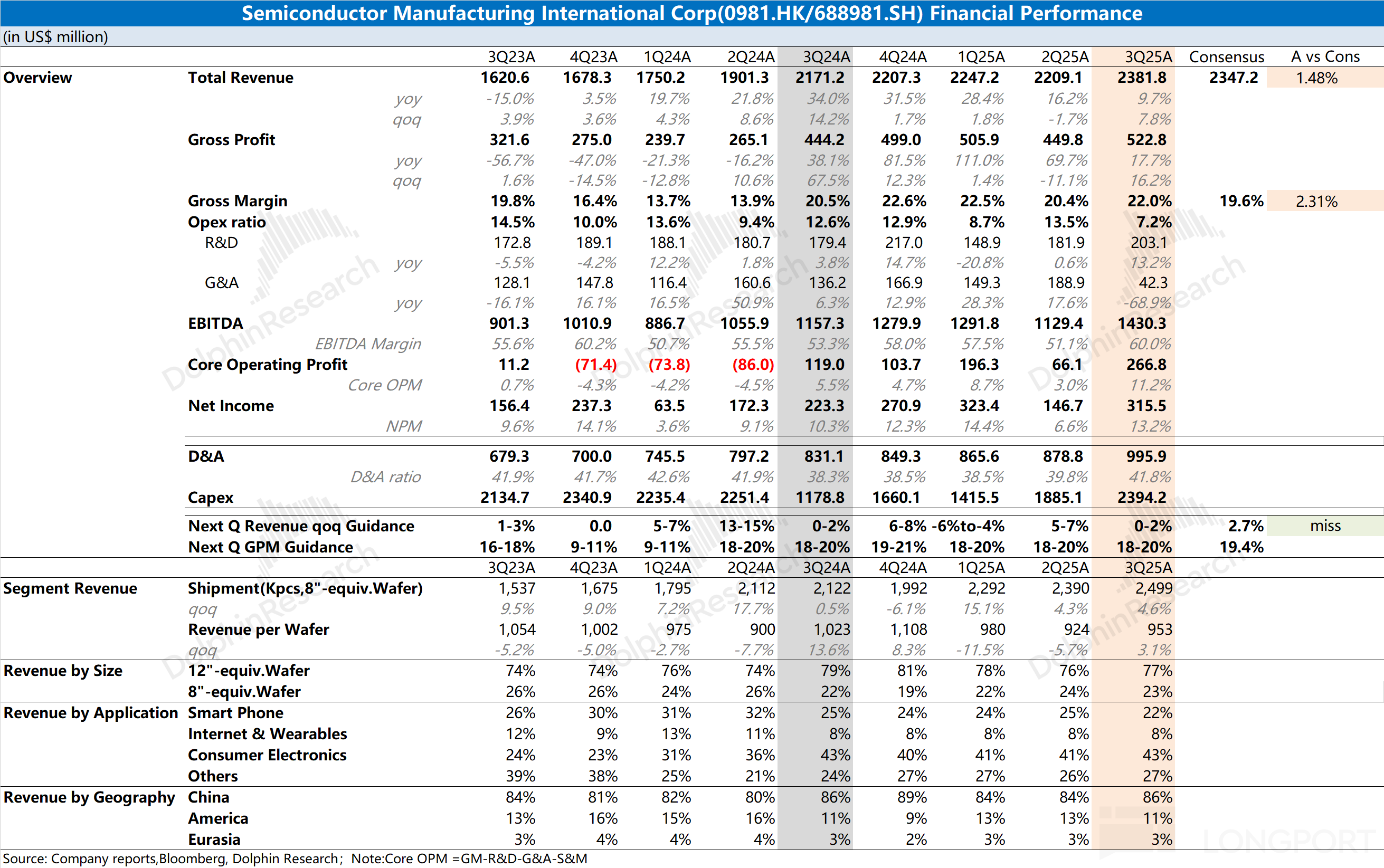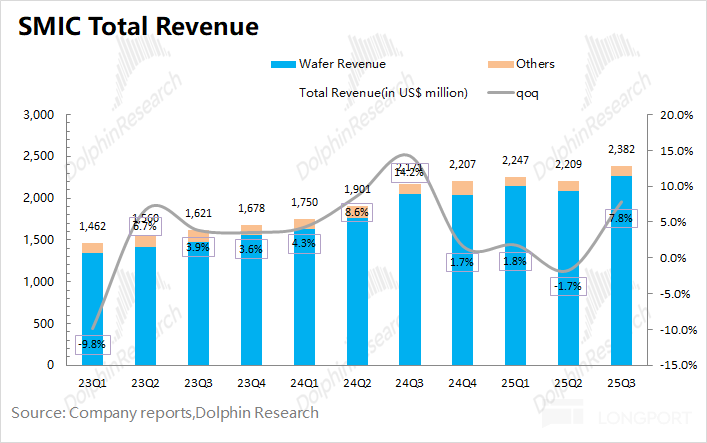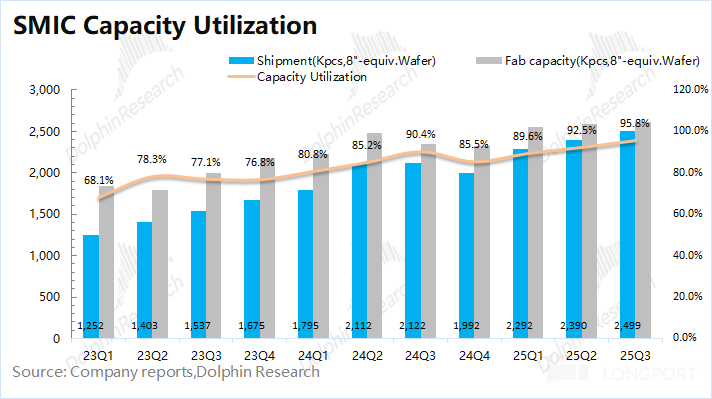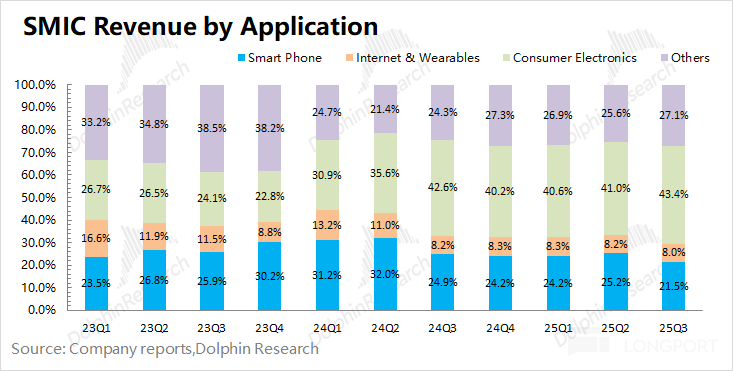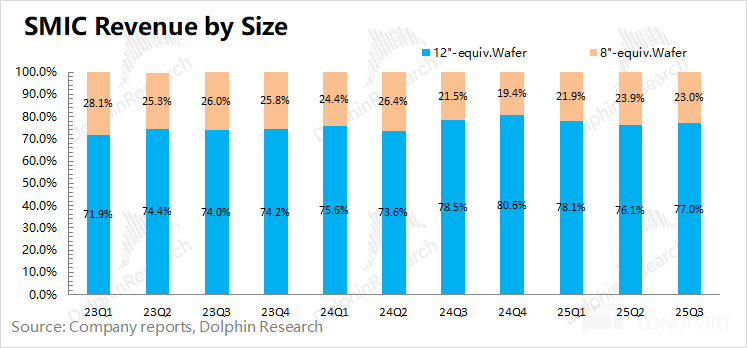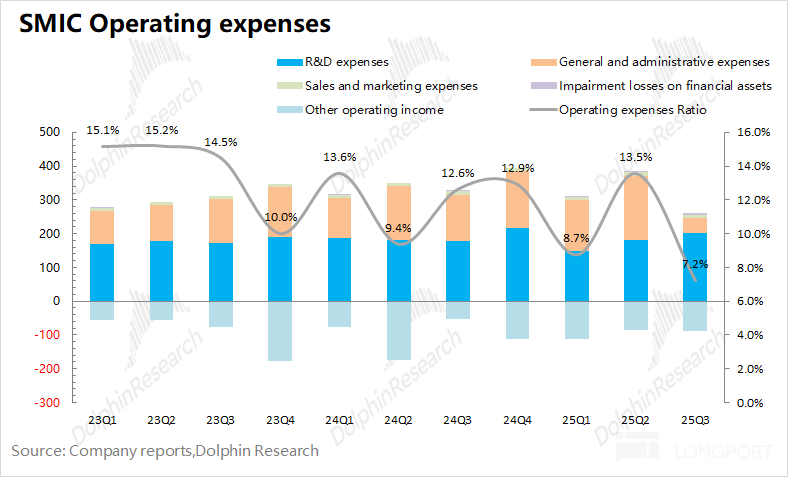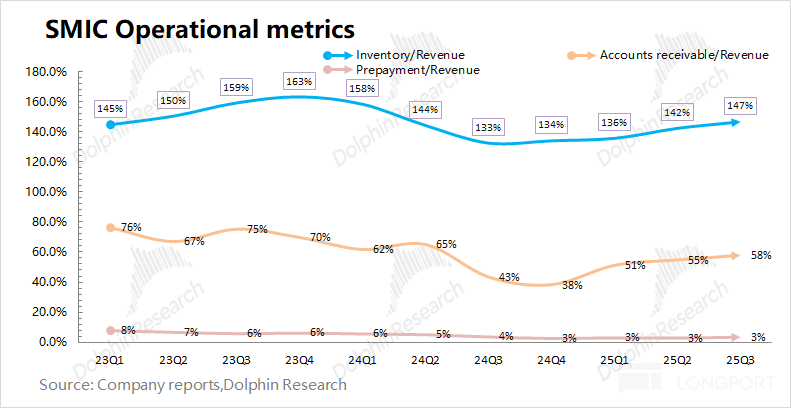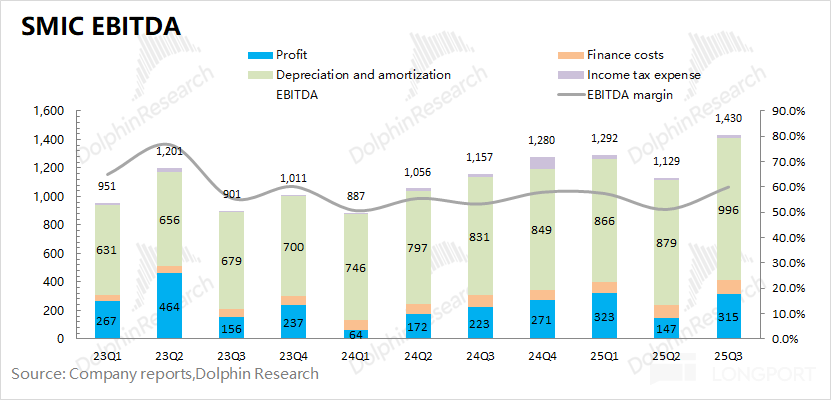
SMIC: Not Competing for Short-term Results, Is AI 'Domestic Chip' the True Belief?

SMIC (0981.HK/688981.SH) released its third-quarter financial report for 2025 (ending September 2025) after the Hong Kong stock market closed on the evening of November 13, 2025, Beijing time. The key points are as follows:
1. Overall Performance: SMIC achieved revenue of $2.38 billion in the third quarter of 2025, basically in line with market expectations ($2.35 billion), with a quarter-on-quarter growth of 7.8%, slightly better than the guidance range (quarter-on-quarter growth of 5-7%). The company's revenue growth this quarter was mainly driven by the recovery in demand for consumer electronics, industrial and automotive, and smart home sectors.
The company's gross margin in the third quarter of 2025 was 22%, above the upper limit of the guidance range (18-20%). The increase in the average selling price of the company's products this quarter ($29 per wafer) exceeded the increase in unit costs ($8 per wafer), leading to a recovery in gross margin this quarter.
2. Detailed Analysis of Three Core Indicators: Revenue, Gross Margin, and Capacity Utilization. The revenue growth this quarter was driven by both volume and price increases, $SMIC(00981.HK) with the company's revenue growth this quarter driven by both volume and price increases. The proportion of 12-inch wafer shipments increased this quarter, structurally driving up the average selling price of products. The company's product shipments increased by 4.6% quarter-on-quarter, while the average selling price increased by 3% quarter-on-quarter.
3. Business Progress: Driven by domestic substitution, the company's current revenue in China remains stable at over 80%. This quarter, consumer electronics, industrial and automotive, and smart home sectors grew quarter-on-quarter, while the mobile phone business declined again quarter-on-quarter.
Even with the help of state subsidies, the company's mobile phone business did not show a significant recovery, with its current share falling to 20%. Meanwhile, the consumer electronics business has become the company's largest source of revenue, accounting for over 40%.
4. Expense and Capital Expenditure: The company's operating expenses mainly come from R&D expenses and administrative expenses, with R&D expenses increasing by 13% year-on-year this quarter, while administrative expenses significantly decreased, affected by reduced factory opening-related expenses this quarter.
The company's capital expenditure this quarter was $2.39 billion. Despite the relatively weak traditional semiconductor downstream, the company still maintains high capital expenditure. As capital expenditure in the fourth quarter is often not low, Dolphin Research speculates$SMIC(688981.SH) that the company may raise its full-year capital expenditure guidance (previously expected to be similar to 2024).
5. SMIC's Guidance for Next Quarter: The company expects revenue to grow 0-2% quarter-on-quarter in the fourth quarter of 2025, corresponding to $2.38-2.43 billion, with market expectations at $2.41 billion; next quarter's gross margin is expected to be 18-20%, with market expectations at 19.4%.

Dolphin Research's Overall View: No need to struggle in the short term, the rise of domestic chips is the real confidence.
SMIC's overall performance this quarter was quite good, mainly due to the unexpected improvement in gross margin, primarily driven by the significant increase in average selling price this quarter, which was much higher than the increase in unit costs.
Compared to this quarter's performance, next quarter's guidance is more important, but the company's expectations for next quarter remain quite flat. The company expects revenue to grow 0-2% quarter-on-quarter next quarter, below market expectations (2.7% quarter-on-quarter growth); the company's gross margin guidance for next quarter remains in the 18-20% range, relatively conservative, also indicating that the company may face pressure from increased unit costs next quarter.
Based on the guidance, the company's management's view of the current traditional semiconductor market remains not very optimistic. Even though the company's gross margin rose to 22% this quarter, the company still failed to signal an improvement or stabilization in gross margin. From the company's perspective, the real recovery of the traditional semiconductor market has not yet arrived, and the performance will continue to "hibernate".
In addition to this quarter's operating data, SMIC's main focus points are as follows:
a) Capital Expenditure and Capacity Situation: The company's capital expenditure this quarter was $2.39 billion, a quarter-on-quarter increase of $500 million. The company previously expected full-year capital expenditure in 2025 to be roughly the same as the previous year, which suggests that the company's capital expenditure for next quarter will be $1.64 billion. Since capital expenditure in the fourth quarter is usually not low, Dolphin Research expects the company may raise its full-year capital expenditure, demonstrating its determination to continue expanding production.
Even though the current traditional semiconductor market has not yet seen a real recovery, the company's gross margin remains around 20%, but SMIC still maintains an annual capital investment of $7-8 billion, pursuing "counter-cyclical expansion".
Driven by continuous high investment, SMIC's current quarterly wafer capacity has reached 2.6 million pieces (equivalent to 8-inch wafers), doubling since the end of 2018. The increase in capacity scale has gradually met the needs of domestic customers, and the company is now firmly in third place in the global wafer market.

b) Gross Margin and Cash Flow Situation: With the current gross margin around 20%, SMIC's annual operating profit is about $1.1 billion. Even with $3-4 billion in annual depreciation and amortization added back, the company's cash flow is still difficult to cover its annual capital expenditure of $7-8 billion. [Free Cash Flow = After-tax Operating Profit + Depreciation and Amortization - Increase in Working Capital - Capital Expenditure]
Historically, SMIC's free cash flow has only turned positive in one year (2021). Driven by the semiconductor upcycle in 2021, the company's gross margin exceeded 30%, and the company also reduced capital expenditure that year, ultimately leading to positive free cash flow.

If we only consider after-tax operating profit, depreciation and amortization, and annual capital expenditure of $7-8 billion, when the company's gross margin steadily rises to around 27% in 2028, the funding gap will just be closed.
c) Domestic and International Views and Pricing Power: Due to SMIC's unique nature, there is a significant divergence in views between domestic and international funds. As seen after the company's second-quarter report, domestic securities firms unanimously "bullish"; while JP Morgan and other foreign securities firms maintain a "bearish" stance. This reflects different investment logics:
① For domestic funds: It is mainly a process of long-term investment, including expectations of narrowing the gap in the semiconductor industry and reflecting the strategic pattern of "supporting the country"; ② For foreign capital: 1) SMIC is not scarce in terms of assets, with options like Samsung, TSMC, UMC, and GlobalFoundries; 2) No need to consider strategic patterns. From a foreign perspective, this is still a "capital black hole" asset, lacking the ability to "self-sustain"; 3) Foreign investment in SMIC also needs to bear risks such as exchange rate fluctuations and geopolitical issues.
Based on the holdings of the Shanghai-Hong Kong Stock Connect, the current domestic holdings of SMIC H shares account for over 50% of the free float, having absolute influence. The company's stock price fluctuations also show a clear correlation with the holdings of the Shanghai-Hong Kong Stock Connect.

From an investment perspective, based on the company's current market value (HKD 604.8 billion), it roughly corresponds to about 50 times PE of the core after-tax operating profit for 2026 (assuming revenue grows by 15% year-on-year, gross margin is 23%, and tax rate is 7%). From a PE perspective, the company's valuation still requires several years of continuous growth to digest.
From a PB perspective, the current PB situation of wafer foundries is roughly "TSMC 9.2>SMIC 3.6>GlobalFoundries 1.7>UMC 1.5". TSMC's PB is the highest (PEG approximately equal to 1) because TSMC's substantial assets are mainly concentrated in advanced processes, generating high economic benefits and having a clear industry-leading advantage.
SMIC's revenue scale is actually relatively close to UMC and GlobalFoundries, although SMIC is slightly ahead in process nodes compared to the other two, its gross margin performance is significantly lower than UMC and GlobalFoundries. The reason SMIC can have a significantly higher PB valuation than the other two is mainly due to the "domestic substitution" and "process breakthrough" expectations.
In the absence of a clear advantage in SMIC's profitability, the current profit of around $1-1.5 billion is difficult to view from a PE perspective. From a PB perspective, if the company's PB valuation reaches above 2 times, it already starts to incorporate "long-term companionship" confidence. Whenever Sino-US tensions escalate or domestic semiconductors make breakthroughs, it will further strengthen the confidence in the "domestic chip chain", directly driving up SMIC's PB valuation.
For ordinary investors, investing in SMIC mainly depends on which part of the money they want to earn. Before technological breakthroughs, from a purely market-oriented perspective, SMIC should be a 1-2x PB heavy asset (referencing UMC, GlobalFoundries).
When the stock price reaches above 2x PB, it includes more confidence in "domestic substitution" and "process breakthrough", with relatively large expectations and stock price volatility, making it a choice for "long-term belief" type investors.
Especially now, with end-users like Alibaba Cloud significantly increasing capital expenditure, and chip procurement being practically confined to domestic chip manufacturers, the value of SMIC as an upstream wafer manufacturer is particularly important.
The following is Dolphin Research's detailed analysis of SMIC:
I. Core Indicators of SMIC: Revenue, Gross Margin, and Capacity Utilization
Core Indicator 1: Revenue
In the third quarter of 2025, SMIC achieved revenue of $2.38 billion, a quarter-on-quarter growth of 7.8%, slightly better than the guidance range (quarter-on-quarter growth of 5-7%). The company's quarter-on-quarter decline last quarter was mainly affected by annual line maintenance and equipment upgrades.
The company's revenue returned to growth quarter-on-quarter this quarter, mainly due to the recovery in demand from downstream markets such as consumer electronics, industrial and automotive, and smart home.

Analyzing from the dimensions of volume and price, the main factors affecting SMIC's revenue growth this quarter:
1) Volume Dimension, SMIC's wafer shipments (equivalent to 8-inch) this quarter reached 2,499 thousand pieces, a quarter-on-quarter growth of 4.6%;
2) Price Dimension, SMIC's single wafer revenue (equivalent to 8-inch) this quarter was $953, a quarter-on-quarter increase of 3.1%.
From the perspective of volume and price decomposition: Driven by high capital expenditure, the company's capacity and output are increasing. The average selling price of the company's products rose again this quarter, mainly driven by the increase in the proportion of 12-inch wafers, structurally driving up the average selling price of products.

Looking ahead to the fourth quarter of 2025, SMIC has provided guidance for a quarter-on-quarter revenue growth of 0-2%, corresponding to $2.38-2.43 billion, with market consensus expectations (quarter-on-quarter growth of 2.7%). Due to the stocking of electronic products in the second and third quarters, there will be a seasonal decline in quarter-on-quarter growth at the end of the year.
On the other hand, the company's guidance for a slight increase in revenue also reflects that the demand in the traditional semiconductor field where the company is currently located is still relatively weak.
Core Indicator 2: Gross Margin
In the third quarter of 2025, SMIC's gross margin was 22%, a quarter-on-quarter increase of 1.6 percentage points, with market consensus expectations (19.6%), above the upper limit of the guidance range (18-20%).
By breaking down the cost structure of the company, we analyze the reasons for the change in SMIC's gross margin this quarter:
Single Wafer Gross Profit = Single Wafer Revenue - Single Wafer Fixed Cost - Single Wafer Variable Cost
1) Single Wafer Revenue: SMIC's single wafer revenue (equivalent to 8-inch) this quarter was $953, a quarter-on-quarter increase of $29 per wafer.
2) Single Wafer Fixed Cost (Depreciation and Amortization): This quarter's single wafer fixed cost (equivalent to 8-inch) was $322, a quarter-on-quarter increase of $7 per wafer. The company's depreciation and amortization this quarter was $804 million, a quarter-on-quarter increase of 7%. With the increase in shipments, the quarter-on-quarter increase in single wafer fixed cost was diluted to 2.3%.
3) Single Wafer Variable Cost (Other Manufacturing Expenses): This quarter's single wafer variable cost (equivalent to 8-inch) was $422, basically flat quarter-on-quarter. The increase in variable costs last quarter was partly due to factors such as equipment upgrades.
4) Single Wafer Gross Profit: SMIC's single wafer gross profit (equivalent to 8-inch) this quarter was $209, a quarter-on-quarter increase of $21 per wafer.
Through cost decomposition, it was found that the company's unit gross profit growth this quarter was mainly due to the increase in product average selling price. With a slight increase in unit costs, the company's gross margin rose to 22% this quarter.

Looking ahead to the fourth quarter of 2025, SMIC still provided a gross margin guidance of 18-20%, with market expectations (19.4%). Although the company's gross margin reached 22% this quarter, the company did not raise the guidance range for next quarter, indicating that the company's management is concerned about the potential pressure of cost increases next quarter, and the downstream demand has not yet seen a real recovery.
Core Indicator 3: Capacity Utilization
The capacity utilization indicator not only reflects SMIC's quarterly operating conditions but also sheds light on the trend of the entire wafer manufacturing industry's prosperity. Especially during relatively sluggish semiconductor periods, paying attention to the capacity utilization indicator helps grasp the supply and demand changes of the company and the industry.
In the third quarter of 2025, SMIC's capacity utilization was 95.8%, and the company's capacity utilization continued to rise this quarter. Based on the company's revenue structure and next quarter's revenue guidance, Dolphin Research believes that the company's capacity utilization recovery this quarter was mainly driven by the recovery in demand for consumer electronics, industrial and automotive, and smart home sectors.
By estimating the company's capacity utilization and shipment situation this quarter, SMIC's total capacity this quarter reached 2,609 thousand pieces, a quarter-on-quarter increase of 1%. Due to the company's annual capital expenditure remaining at $7-8 billion in recent years, the company's capacity scale continues to expand.
SMIC's capital expenditure this quarter was $2.39 billion. If the company maintains its previous full-year capital expenditure target (similar to 2024), then the company's capital expenditure in the fourth quarter will be $1.64 billion. Since the fourth quarter is often not low, Dolphin Research expects the company may raise its full-year capital expenditure target, demonstrating its determination to continue expanding production.

II. Business Perspective on SMIC
After reviewing the three core indicators, Dolphin Research and everyone will take a comprehensive look at SMIC's quarterly business situation:
2.1 Various Downstream Markets
Consumer electronics business remains the company's largest source of revenue this quarter, accounting for 43.4%. Driven by the stocking demand for electronic products in the second half of the year, consumer electronics products grew quarter-on-quarter this quarter.
This quarter, SMIC's smartphone business revenue share fell to 21.5%, with quarterly revenue falling to $490 million quarter-on-quarter. Comparing the performance of the smartphone business in the first three quarters of this year with the same period last year, the smartphone business did not show significant growth, which also reflects that the state subsidy policy did not significantly drive the company's smartphone business.
Combining the performance of various downstream businesses, the company's revenue growth this quarter was driven by consumer electronics, industrial and automotive, and smart home businesses. The smartphone business declined by 7.4% quarter-on-quarter, being a drag on the company's business this quarter. As the smartphone business share declines, its impact on the company's overall performance is also significantly weakened.

2.2 Various Wafer Sizes
Since the first quarter of 2022, SMIC no longer discloses the revenue share of each process node, only disclosing the revenue share of 8-inch and 12-inch wafers, making it impossible to see the revenue changes of each node in detail.
This quarter, SMIC's 12-inch wafer revenue share was 77%, showing a recovery, mainly due to the stocking demand from downstream markets such as consumer electronics. Specifically, based on the share of the two sizes and the company's revenue, SMIC's 12-inch wafer revenue grew by 9.1% quarter-on-quarter this quarter, while 8-inch wafer revenue increased by 3.8% quarter-on-quarter.
In the past two quarters, 8-inch wafers continued to grow quarter-on-quarter, mainly supported by the stocking demand for 8-inch wafers in industrial and automotive businesses. As the stocking demand weakens, 12-inch wafers have become the main driving force for the company's performance again.

2.3 Regional Distribution
SMIC has adjusted the regional revenue distribution criteria from the original "North America/China Mainland and Hong Kong/Europe and Asia" to the current "China/US/Europe and Asia". Due to the adjustment of the criteria, there are slight differences in the data.
From the regional revenue this quarter, China's revenue remained at 86%, still the company's largest source of revenue. In addition, the company's revenue share in the US/Europe and Asia this quarter remained at 11% and 3%, respectively.
SMIC's revenue in China this quarter was $2.05 billion, a quarter-on-quarter increase of 10%, driven by the stocking demand in the second half of the year. With the help of the state subsidy policy, the company's domestic market revenue has accelerated year-on-year growth in the past few quarters, but this quarter's domestic revenue year-on-year growth rate fell to 9%, indicating that the impact of state subsidies is gradually weakening.

III. Operating Data Perspective on SMIC
3.1 Operating Expenses
From the perspective of operating expenses, SMIC's operating expenses this quarter were $170 million, significantly reduced, mainly due to the reduction in the company's administrative expenses this quarter. The operating expense ratio fell to 7.2% this quarter.
Breaking down the operating expenses this quarter, R&D expenses were $200 million, general and administrative expenses were $40 million, and sales and marketing expenses were $10 million. Among them, general and administrative expenses decreased by $150 million quarter-on-quarter, mainly due to the reduction in new factory opening expenses this quarter.

3.2 Operating Indicators:
From the perspective of operating indicators, mainly observing the company's inventory and accounts receivable:
- SMIC's inventory this quarter was $3.49 billion, a quarter-on-quarter increase of 11%;
- SMIC's accounts receivable this quarter was $1.38 billion, a quarter-on-quarter increase of 14%.
Combining the relationship between inventory & accounts receivable and revenue in the balance sheet, this quarter's inventory/revenue and accounts receivable/revenue were 147% and 58%, respectively. From the perspective of operating indicators, SMIC's inventory ratio has increased, and the company's third-quarter stocking is usually increased, but it is still at a relatively reasonable level overall.

3.3 EBITDA Indicator:
From the EBITDA perspective, SMIC's earnings before interest, taxes, depreciation, and amortization this quarter were $1.43 billion, showing a significant recovery.
Breaking down the indicators, SMIC's earnings before interest, taxes, depreciation, and amortization mainly come from the release of operating profit and depreciation and amortization. It is estimated that this quarter's profit margin (before interest, taxes, depreciation, and amortization) has recovered to 60%. The increase in the company's profit this quarter was mainly driven by the improvement in gross margin and the reduction in administrative expenses.

<End Here>
Dolphin Research's Historical Articles on SMIC:
Earnings Season
August 7, 2025, Conference Call "SMIC (Minutes): Mobile and Other Expectations Revised Down, Prices Will Continue to Decline"
August 7, 2025, Earnings Review "SMIC: Guidance Big "Crash", When Will "Domestic Chips" Break Through?"
February 10, 2025, Conference Call "SMIC (Minutes): Capital Expenditure Plan Remains the Same as Last Year"
February 10, 2025, Earnings Review "SMIC: "State Subsidies" in Hand, Hard to Resist the Cycle?"
November 8, 2024, Conference Call "SMIC: The Potential Risk Next Year is "No Increase in Price with Increase in Volume" (24Q3 Conference Call)"
November 7, 2024, Earnings Review "SMIC: Can It Support the Hope of the Whole Village?"
August 9, 2024, Conference Call "SMIC: 12-inch Capacity Near Full Load (24Q2 Conference Call Minutes)"
August 8, 2024, Earnings Review "SMIC: Soaring Against the Wind, Delivering Explosive Guidance"
May 10, 2024, Conference Call "SMIC: Full-Year Revenue Growth Will Exceed Industry Average (24Q1 Conference Call)"
May 9, 2024, Earnings Review "SMIC: The Long Low Valley, Finally Almost Over"
February 7, 2024, Conference Call "The Reshuffle of Mature Processes Requires 4-5 Years (SMIC 4Q23 Conference Call)"
February 6, 2024, Earnings Review "SMIC: Counter-Cyclical Expansion, Bringing Down Guidance"
November 10, 2023, Conference Call "W-Shaped Trend, Recovery May Be Delayed by a Year (SMIC 3Q23 Conference Call)"
November 10, 2023, Earnings Review "SMIC: Long Cycle, Waiting for the East Wind"
August 11, 2023, Conference Call "The Increment of Mobile Phones Actually Comes from "Trade-in"? (SMIC 2Q23 Conference Call)"
August 11, 2023, Earnings Review ""Bland" SMIC: How Long Until Recovery?"
May 12, 2023, Conference Call "12-inch Urgent Orders, Semiconductor Begins Structural Recovery (SMIC 23Q1 Conference Call)"
May 11, 2023, Earnings Review "SMIC: The Chip Cycle Can't Hide the Alpha Light"
February 10, 2023, Conference Call "High Depreciation Pressures Gross Margin, Improvement Needs to Wait for the Second Half (SMIC 22Q4 Conference Call Minutes)"
February 10, 2023, Earnings Review "SMIC: The Decline is Visible to the Naked Eye, But Now Bad is Good?"
November 11, 2022, Conference Call "Even with Semiconductor Downturn, Capital Expenditure Remains Uncut (SMIC 22Q3 Conference Call)"
November 11, 2022, Earnings Review "SMIC: Long-Term Belief, Can't Escape the "Cycle Curse""
August 12, 2022 "How Does SMIC Cope with the Semiconductor Downturn Cycle? (22Q2 Conference Call Minutes)"
August 11, 2022 "Prices Can't Rise, SMIC Stubbornly Resists the "Cycle Calamity""
May 13, 2022, Conference Call "Limited Impact of the Pandemic, Semiconductor Shows Structural Shortage (SMIC Conference Call Minutes)"
May 12, 2022, Earnings Review "Pandemic Kneels, Market Kneels? SMIC's Performance Doesn't "Kneel""
February 11, 2022, Conference Call "Beyond Industry Price Increases, SMIC Expands Again"
February 10, 2022, Earnings Review "SMIC: "Rising" Voices Continue, Performance Continues to Be Bullish | Read the Financial Report"
November 12, 2021, Conference Call "After Exceeding Expectations, SMIC's Stock Plummets, What Did Management Communicate?"
November 11, 2021, Earnings Review "Stop Questioning the Cycle Peak, SMIC is Still Bullish!"
August 6, 2021, Conference Call "After SMIC 21Q2 Earnings, How Does Management View It?"
August 5, 2021, Earnings Review "SMIC: The Rising Chinese "Chip" Power"
In-Depth
June 20, 2025, Company In-Depth "An Alternative Perspective on SMIC: How Big is the Faith Gap Behind the Hong Kong A Price Difference?"
December 29, 2022, Industry In-Depth "Semiconductor Avalanche? True Elasticity Only Comes After the Most Severe Decline"
June 24, 2022, Industry In-Depth "Order Cuts, Order Cuts, Order Cuts, Is the Semiconductor Really Going to "Change the Sky"?"
July 16, 2021, Company In-Depth "SMIC (Part 2): The Undervalued Chinese "Chip""
July 9, 2021, Company In-Depth "SMIC (Part 1): On the Leading "Chip" Strategy"
The risk disclosure and statement of this article: Dolphin Research Disclaimer and General Disclosure
The copyright of this article belongs to the original author/organization.
The views expressed herein are solely those of the author and do not reflect the stance of the platform. The content is intended for investment reference purposes only and shall not be considered as investment advice. Please contact us if you have any questions or suggestions regarding the content services provided by the platform.

